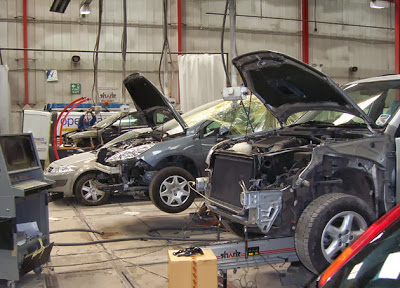You’ve been in a car accident, and you’re a bit shaken up but you’re OK. After you’ve called the police, and your insurance company, it’s time to deal with the after-effects on your vehicle. It’s busted up pretty good. You need to get it fixed.
Contact Your Insurance Company
The first step is to contact your auto insurance company – they usually have a list of preferred shops. Submit your insurance claim on a proof of loss claim form. Next, ask about the list of the insurance company’s preferred repair shops. This info should be fairly easy to get.
Insurance companies don’t always automatically accept a shop’s quotes, so make sure that you get a few shops to check out. The insurer might accept the repair shop’s first estimate for damages or an insurance representative might actually pay the shop a visit. If this happens, the insurance adjuster who talks to the shop manager will try to negotiate a fair price for the repairs.
This isn’t always in your best interest, however. Why? Because the quality of the repairs only need to be enough to make the vehicle drivable again as far as the insurer is concerned. If your concerns extend to the resale value of the car, you’ll want the highest-quality job possible.
This might mean meeting with the shop manager and the adjuster yourself to negotiate a somewhat higher price or at least a guarantee that a certain minimum standard will be met. Why a higher price? There’s often an unspoken truth in the auto repair industry that you get what you pay for – it’s true. When a shop is squeezed on the repair price, quality often suffers as workers spend less time on your car to make sure that the shop doesn’t lose money on the job.
Choose A Repair Shop
Once you’re satisfied that a good job will be done on your car, it’s time to look over the estimate. Don’t just take the shop’s word for it that they will do a good job. The estimate should specify what repairs will be done, whether parts are to be repaired or replaced, whether new or used parts will be used if items need to be replaced, and whether OEM (original manufacturer) parts will be used as versus generic or “off brand” parts.
If you’re not confident that the shop will do a good job, you have the right to choose a different repair place. When you choose your shop, the responsibility for a good repair job falls on you and not the insurer – just keep that in mind. Any dispute about the quality of the repair will be between you and the shop, not the insurer and the shop.
A few places to help you find a good shop include:
- Automotive Service and Repair Association
- Motor Dealers Association
- Certified Collision Automotive Repair
You can also check with the Alberta Motor Vehicle Industry Council to verify the shop you’re working with is licensed. When you’ve found a shop you like, tell your insurer.
Follow Up With The Shop
Look over your vehicle before you pay the shop any money from the insurance company. Make sure that your vehicle is restored to a condition similar to what you had prior to the accident. Sometimes, the shop you choose just doesn’t do a good job. It happens. Find out who sets the repair standards at the shop and talk to this person.
Don’t be antagonistic – instead, try to remain calm and explain your dissatisfaction. If you cannot get the issue resolved with the shop, contact your insurer to tell them that the shop hasn’t fixed the vehicle properly. If it’s a shop chosen by the insurer, there’s a pretty good chance that your car will be fixed properly.
A Note About Repairing and Replacing Your Vehicle
Some insurance companies will choose to repair or replace your vehicle, rather than allow you to choose the repair shop. The ability for the insurer to do this is usually spelled out in your insurance policy. In these cases, you’ll get a written notice straight from the insurer. The insurer will then assume full control of the repair process and is responsible for doing a good job on the repairs. If the vehicle cannot be repaired, it will replace your vehicle.
Bill Nixon has had to fix a few vehicles in his lifetime. He likes to help others by posting on a variety of blog sites.


